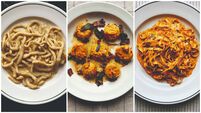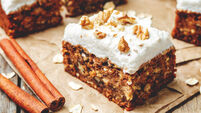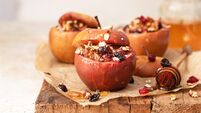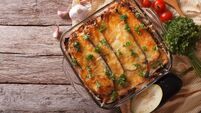Ballymaloe Sourdough Bread
Every loaf is an adventure. Each will be slightly different and every time you make a loaf you will learn more about the process. Enjoy experimenting and remember, people have been making sourdough bread for centuries.
Method
Prepare your sourdough starter, as per The New Ballymaloe Bread Book by Darina Allen, published by Gill Books.
Put the starter, water, flours and wheat germ in the bowl of a stand mixer. Mix with a dough hook on a slow speed for a few seconds, until the dough has combined. Rest the dough for 5 minutes.
After resting, add the salt and turn the mixer on a slow speed – if you beat it too fast at this stage, you can break the gluten. When the dough is sticking to the sides of the bowl and coming away in strings, this is the gluten being developed. Increase the speed and continue to mix until it doesn’t stick to the sides of the bowl and the dough hook lifts the dough cleanly out.
Place the dough in a bowl, cover and leave to rest in the fridge for 24 hours.
The next day, for the first shaping, pour the dough out of the bowl onto a clean work surface and knock it back. Stretch and fold the dough a few times, then shape it into a smooth, tight, round ball and leave to rest for 15-20 minutes in a cool kitchen or 5–10 minutes in a warm kitchen.
Stretch and fold the dough a few times. Turn and push to shape it into a smooth, tight round ball.
For the second shaping, flip your dough over, flatten and spread it out with your fingers. Pull all the edges into the centre of the dough – this helps to trap the CO2 and gases in the dough to give it a nice airy crumb. Flip it back over with a dough scraper (or roll it over) and shape into a smooth, tight, round ball again. The tighter and less sticky the ball is, the better it will hold its shape and rise in the oven. If it’s too tight, though, the surface will rip and become sticky again. If this happens, rest the dough again for 10-15 minutes and repeat.
Flip the dough over. Pull all the edges into the centre of the dough. Flatten and spread it out with your fingers. Put the dough upside down into a lined, floured banneton (or in a 16-20cm bowl lined with a clean linen tea towel and floured) and leave in the fridge, covered, overnight or for up to 24 hours.
The next day, put a casserole/Dutch oven with its lid on in the oven to preheat. (For this recipe, the lid must be flat. Alternatively, you could cook the loaf directly on a hot baking tray in the oven, but this is the least good option for home baking.) Preheat the oven fully to its maximum temperature or at least 250°C/Gas Mark 9. It is essential that the casserole/Dutch oven is fully preheated, overwise the bread will stick firmly to the base. It will take 30-35 minutes for the heat to penetrate completely.
Meanwhile, take the dough out of the fridge and allow it to sit at room temperature while the casserole/Dutch oven is preheating.
Using an oven mitt or thick tea towel, lift the hot casserole/Dutch oven out onto a pot rack. Lift off the lid and carefully turn the dough out of the banneton onto the upturned lid. Slash the top with a sharp serrated knife or baker’s blade (lame) and mist lightly with water (optional).
Replace the casserole/Dutch oven base on top of the lid and quickly put it back in the hot oven. Reduce the temperature to 230°C/Gas Mark 8 and bake for 20 minutes. Remove the upturned base and continue to bake the bread on the lid for 10-15 minutes, until the crust is dark golden brown. When fully cooked, the bread will feel light and will sound hollow when tapped on the base. Cool on a wire rack.
Ballymaloe Balloons (Cheats Doughnuts)
There was a brilliant reaction to these balloons when I recently made them on the Today Show. My mother-in-law, Myrtle Allen, made them regularly for her children, then passed on the recipe to her grandchildren and great-grandchildren.
Preparation Time
40 minsIngredients
150g white flour
2 teaspoons caster sugar
1 level teaspoon baking powder
pinch of salt
175-200ml full-fat milk plus more if needed
light olive or vegetable oil, for deep-frying
extra caster sugar or cinnamon sugar (granulated sugar mixed with a little ground cinnamon), to coat
Method
Sieve the dry ingredients into a bowl. Mix to a thick batter (dropping consistency) with the milk.
Heat the oil in a deep-fryer to 190°C. If you don’t have a deep-fryer, heat 4cm light olive or vegetable oil in a deep pan.
Take a heaped teaspoonful of the mixture and gently push it off with your finger so that it drops in a round ball into the fat. Fry until puffed and golden. Remove and drain on kitchen paper. Repeat the process until you have used up all the batter.
Roll the balloons in caster sugar or cinnamon sugar and serve at once. These are also delicious with sweet apple sauce flavoured with a little cinnamon or a bowl of lemon.
Irish cheese did brilliantly. Carrig Bru and Cooleeny won silver, and Boyne Valley Bán and Blue Cheese both won bronze.
Bravo to Tom Burgess’ whose Mount Leinster Clothbound Cheddar has just won two “Super Golds” in the World Cheese Awards in Trondheim, Norway.
Mount Leinster was awarded two separate trophies for World’s Best Cheddar and Best Irish Cheese.
The World Cheese Awards, hosted by the Guild of Fine Food, is a highly competitive and globally renowned event that brings together the finest cheese producers from around the world.
- For more information, see
Kinsale Wild Red Mead is flavoured with Wexford blackcurrants, dark cherries and pure honey and is made in the family-run meadery in Kinsale, Co. Cork.
It is so good served with plates of tapas, or Christmas goodies – mince pies, Christmas cake, chocolate log or a cheeseboard.
Try Mulled Wild Red Mead, warm with cinnamon, star anise, a strip of orange peel and honey.
How about that for a warming festive drink for cold winter days?












